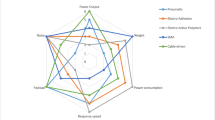Abstract
Purpose
Automatic robotic platforms for robot-aided spinal surgery are mostly employed for drilling the pedicle screw path and do not adapt the tool rotational speed depending on the variation of the bone density. This feature is highly desirable in control strategies for robot-aided pedicle tapping, which may result in a poor quality thread if the surgical tool speed is not adequately tuned depending on the bone density to be threaded. Therefore, the objective of this paper is to propose a novel semi-autonomous control for robot-aided pedicle tapping that is able to (i) identify the bone layer transition, (ii) adapt the tool velocity depending on the detected bone layer density and (iii) stop the tool tip before propulsion of the bone boundaries.
Methods
The proposed semi-autonomous control for pedicle tapping consists of: (i) a hybrid position/force control loop that allows the surgeon to move the surgical tool along a pre-planned axis and (ii) a velocity control loop that allows him/her to finely tune the tool rotational speed by modulating the tool–bone interaction force along the same axis. The velocity control loop integrates also a bone layer transition detection algorithm that dynamically limits the tool velocity depending on the bone layer density. The approach was tested on the Kuka LWR4+ provided with an actuated surgical tapper which was used to tap a wood specimen simulating the bone layer density characteristics and bovine bones.
Results
A normalized maximum time delay in the bone layer transition detection of 0.25 was achieved by the experiments. A success rate of \(100\%\) was achieved for all the tested tool velocities. The proposed control achieved a maximum steady-state error of 0.4 rpm.
Conclusion
The study demonstrated high capability of the proposed approach to i) promptly detect transition among the specimen layers and ii) adapt the tool velocities depending on the detected layers.





Similar content being viewed by others
References
Boos N, Webb J (1997) Pedicle screw fixation in spinal disorders: a european view. Eur Spine J 6(1):2–18
Erkan S, Hsu B, Wu C, Mehbod AA, Perl J, Transfeldt EE (2010) Alignment of pedicle screws with pilot holes: can tapping improve screw trajectory in thoracic spines? Eur Spine J 19(1):71–77
Suk S-I, Kim W-J, Lee S-M, Kim J-H, Chung E-R (2001) Thoracic pedicle screw fixation in spinal deformities: are they really safe? Spine 26(18):2049–2057
Zhao Z, Jordan S, Tse ZTH (2019) Devices for image-guided lung interventions: State-of-the-art review. Proc Inst Mech Eng [H] 233(4):444–463
Tian N-F, Xu H-Z (2009) Image-guided pedicle screw insertion accuracy: a meta-analysis. Int Orthop 33(4):895–903
Hu X, Ohnmeiss DD, Lieberman IH (2013) Robotic-assisted pedicle screw placement: lessons learned from the first 102 patients. Eur Spine J 22(3):661–666
Ghasem A, Sharma A, Greif DN, Alam M, Al Maaieh M (2018) The arrival of robotics in spine surgery: a review of the literature. Spine 43(23):1670–1677
Jin H, Hu Y, Tian W, Zhang P, Song Z, Zhang J, Li B (2016) Kinematics and cooperative control of a robotic spinal surgery system. Robotica 34(1):226–242
Hu Y, Jin H, Zhang L, Zhang P, Zhang J (2013) State recognition of pedicle drilling with force sensing in a robotic spinal surgical system. IEEE/ASME Trans Mechatron 19(1):357–365
Ong F, Bouazza-Marouf K (1999) The detection of drill bit break-through for the enhancement of safety in mechatronic assisted orthopaedic drilling. Mechatronics 9(6):565–588
Sun Y, Wang L, Jiang Z, Li B, Hu Y, Tian W (2020) State recognition of decompressive laminectomy with multiple information in robot-assisted surgery. Artif Intell Med 102:101763
Louredo M, Díaz I, Gil JJ (2012) Dribon: a mechatronic bone drilling tool. Mechatronics 22(8):1060–1066
Díaz I, Gil JJ, Louredo M (2013) Bone drilling methodology and tool based on position measurements. Comput Methods Programs Biomed 112(2):284–292
Qu H, Zhao Y (2021) Advances in tissue state recognition in spinal surgery: a review. Front Med 15(4):575–584
Lauretti C, Cordella F, Tamantini C, Gentile C, di Luzio FS, Zollo L (2020) A surgeon-robot shared control for ergonomic pedicle screw fixation. IEEE Robotics Autom Lett 5(2):2554–2561
Cordella F, Di Corato F, Loianno G, Siciliano B, Zollo L (2013) Robust pose estimation algorithm for wrist motion tracking. In: 2013 IEEE/RSJ International Conference on Intelligent Robots and Systems, pp. 3746–3751 . IEEE
Romeo RA, Lauretti C, Gentile C, Guglielmelli E, Zollo L (2021) Method for automatic slippage detection with tactile sensors embedded in prosthetic hands. IEEE Trans Med Robotics and Bionics 3(2):485–497
Zhou S, McCarthy I, McGregor A, Coombs R, Hughes S (2000) Geometrical dimensions of the lower lumbar vertebrae-analysis of data from digitised ct images. Eur Spine J 9(3):242–248
Acknowledgements
This work was supported by the European Union’s Horizon 2020 Research and Innovation Program with the Leveraging AI based technology to transform the future of healthcare delivery in Leading Hospitals in Europe (ODIN) Project under Grant Agreement 101017331 (CUP: C85F21000670006).
Author information
Authors and Affiliations
Corresponding author
Ethics declarations
Conflict of interest
The authors have no relevant financial or non-financial interests to disclose. No ethical approval is required for this study.
Additional information
Publisher's Note
Springer Nature remains neutral with regard to jurisdictional claims in published maps and institutional affiliations.
Rights and permissions
Springer Nature or its licensor (e.g. a society or other partner) holds exclusive rights to this article under a publishing agreement with the author(s) or other rightsholder(s); author self-archiving of the accepted manuscript version of this article is solely governed by the terms of such publishing agreement and applicable law.
About this article
Cite this article
Lauretti, C., Cordella, F., Saltarelli, I. et al. A semi-autonomous robot control based on bone layer transition detection for a safe pedicle tapping. Int J CARS 18, 1745–1755 (2023). https://doi.org/10.1007/s11548-023-02855-9
Received:
Accepted:
Published:
Issue Date:
DOI: https://doi.org/10.1007/s11548-023-02855-9




